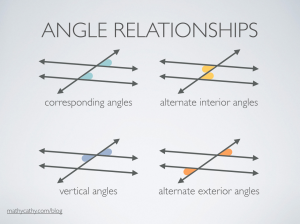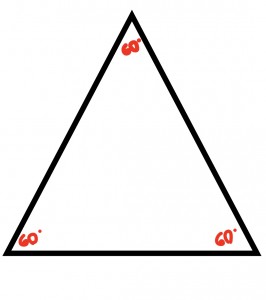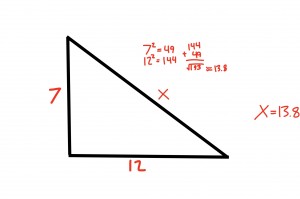Angle Relationships
In class we started learning about the types of angle relationships that exist. These include: corresponding, alternate/same side interior angles, alternate/ same side exterior angles, and vertical angles. All these angles are formed by parallel lines.
Angles In a Triangle
There are 3 sides to a triangle and everybody should know that. That means that a triangle also has 3 angles. The sum of all these angles added up is 180°. With any tupe of triangle, this is going to be the case. Every triangle is added up to 180°.
Triangle Inequality
When the side lengths of the two small triangles, once you add them up, are less than the the larger side length they do not form a triangle. That is why when you compare the side lengths with each other you can see that once you add them and the sum is less than the larger side length that indicates it wont make a triangle. The three sets of side lengths that do not form a triangle are different from the ones that do because once again the ones that don’t their sum is less than the larger side length. But the ones that do is the opposite they two small lengths need to add up to a larger number than the larger side length.
Triangle Side Length Pattern
There are patterns between the areas of the two smaller squares and the area of the larger square that form the triangle. One of the patterns are if the three squares have sides that makes an acute triangle, then the sum of the areas of the two small squares will be bigger than the larger area. If the three squares have sides that make an obtuse triangle, then the sum of the small square area will be smaller than the larger area. And if the three sides that make a right triangle, then the sum of the two small square areas will have to be equal to the larger area.
Square Roots
Square root is how many times do you need to multiply a number by itself to get the area. To estimate square root first, solve for the number by multiplying it 2 times it self. If it has a decimal you need to decide wether is lower than . 4 or higher than .5. If it is lower than .4 you leave it as it is but if its higher than .5 you need to round it. Perfect squares have a square root as a whole number. Non-perfect squares have decimals in the number that us when you decide wether to round it or not.
Pythagorean Theorem
Today in class we learned about the Pythagorean Theorem. It is where you find a missing length or missing leg of a triangle. When looking for the missing length you have to also pay attention to the other numbers. If the length is missing you subtract and if the hypotenuse is missing you add.







Leave a Reply